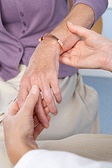This medical examination routinely did and monitored by healthcare professionals to help assess the general health of a person. Vital signs are useful in detecting or monitoring medical problems. The normal ranges vary with person to person, age, weight , gender, and overall health. The four primary vital signs include:
, gender, and overall health. The four primary vital signs include:
- Body temperature
- Pulse rate (Heart rate)
- Respiration rate (rate of breathing)
- Blood pressure
English: Pulse evaluation Deutsch: Pulstastung (Photo credit: Wikipedia)
evaluation Deutsch: Pulstastung (Photo credit: Wikipedia)

The temperature
Body temperature is usually taken in any of the following methods:
Oral
It is by mouth placed under the tongue using either a classic glass thermometer or a digital thermometer that uses an electronic probe to measure body temperature. This method is the preferred among adults.
Rectal/Anal
The temperature taken rectally using a glass or a digital thermometer. The thermometer inserted in the anus about 1 inch. The anal reading is 1 degree higher because it is higher than the core temperature compared to the oral method. This method is the preferred among children.
The thermometer placed under the arm using a glass or a digital thermometer. The
Tympanic
A special thermometer used for this reading. It goes inside the ear to obtain the body's core temperature.
Temporal
A special thermometer used to quickly measure the temperature of the skin on the forehead and swiped along one side of the face.
Skin
These are strips that measure the patient's temperature. This method used when there is no other way to get the temperature reading available because the accuracy in not good.
II. Pulse Rate
This measures the number of times the heart beats per minute (BPM). It is the physical expansion of the artery as the heart pushes blood to the arteries. Taking the pulse rate will also determine the strength of the pulse and the heart rhythm. Pulse rate increases with exercise, illness, injury, and emotions. It varies with age. Infants have higher beats per minutes compared to adults. Place the tips of your index and middle fingers just proximal to the patient wrist on the thumb side to measure the radial pulse rate.
Normal Values
- Infant: 100 to 130
bpm - Child: 80 to 100
bpm - Adult: 60 to 100
bpm
Pulse site
- Brachial
- Carotid
- Dorsal pedal
- Femoral popliteal
- Posterior tibial
- Radial
- Temporal
- Common sites: carotid and radial pulse site
Related Terms
Bradycardia is a condition of a heart rate consistently below 100bpm . Beating is too slow- Tachycardia when the heart is above 100
bpm . Beating is too fast - Strong/Regular pulse indicates that there is an adequate force and consistent beats
- Weak indicates a poor force contraction
- Irregular indicates an arrhythmia. Out of normal rhythm
Peripheral Pulse Assessment Grading System
- 0-3 scale
- 0 absent
- 1+ weak/thready pulse
- 2+ normal
- 3+ full, firm pulse
Pulse Amplitude Classification
- 0 absent
- 1+ diminished
- 2+ normal
- 3+ moderately increased
- 4+ markedly increased
III. Respiratory Rate
The respiratory rate is the number of breaths a person takes per minute, that is an inhalation-exhalation cycle. Respiration recorded as breaths per minute. It varies with age and increases with fever, illness, or other medical
Inspiration - to breathe air into the lungs
Expiration - to breathe air out of the lungs
Normal Rate
- Infant 30 to 50 respiration per minute
- Adults 12 to 18 respiration per minute
IV. Blood Pressure
Blood pressure is the force that moves blood through our circulatory system. I have a blog post on this topic.

































